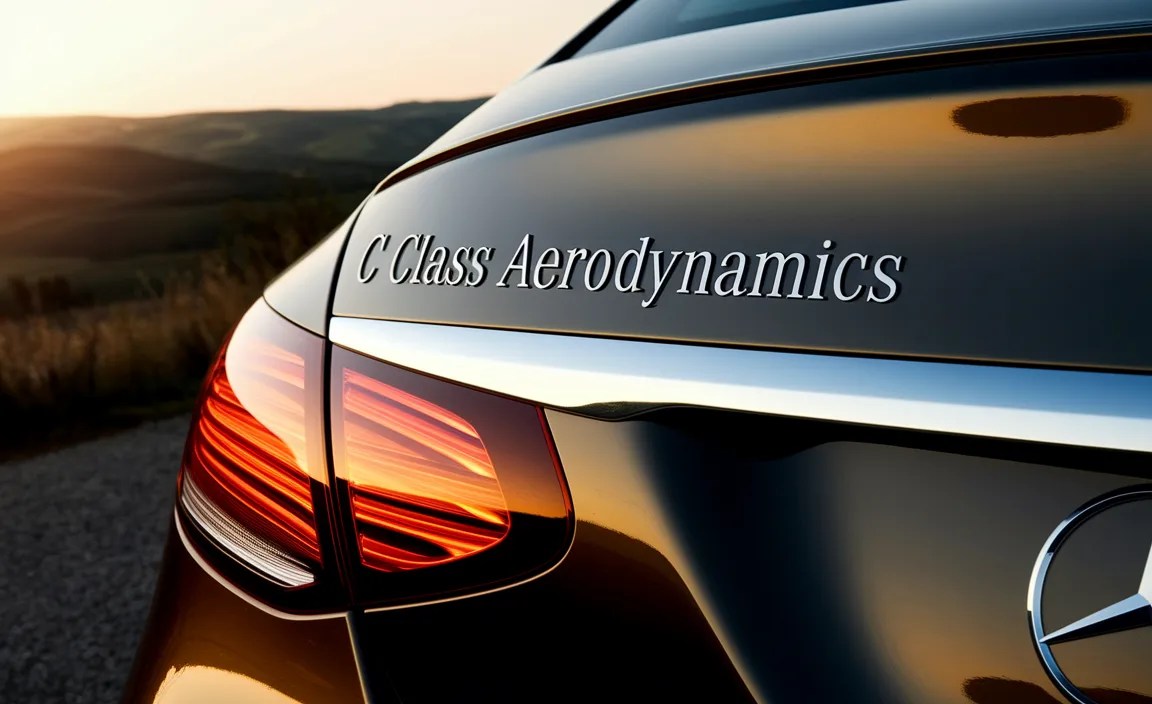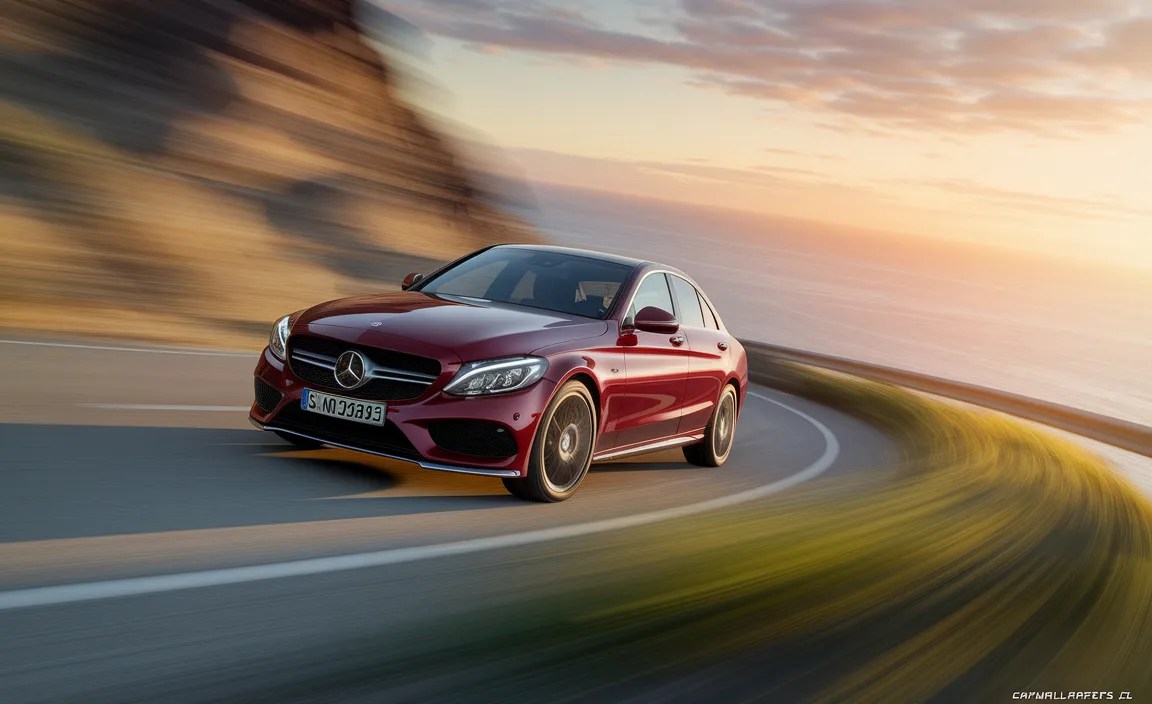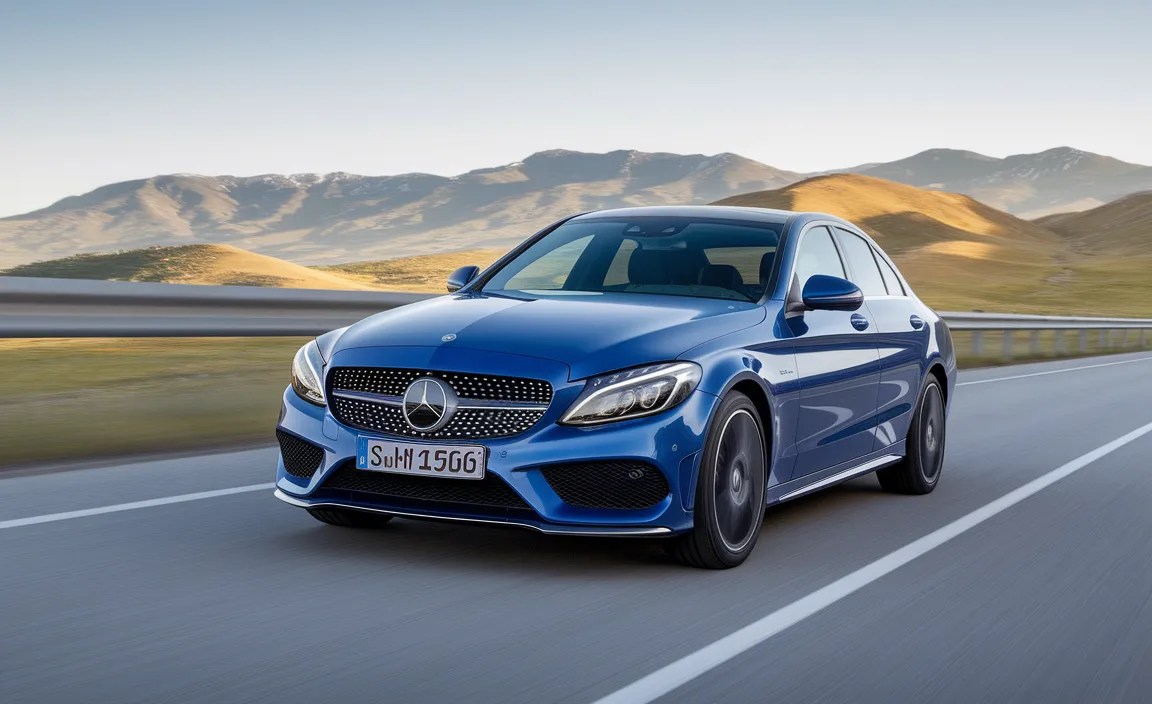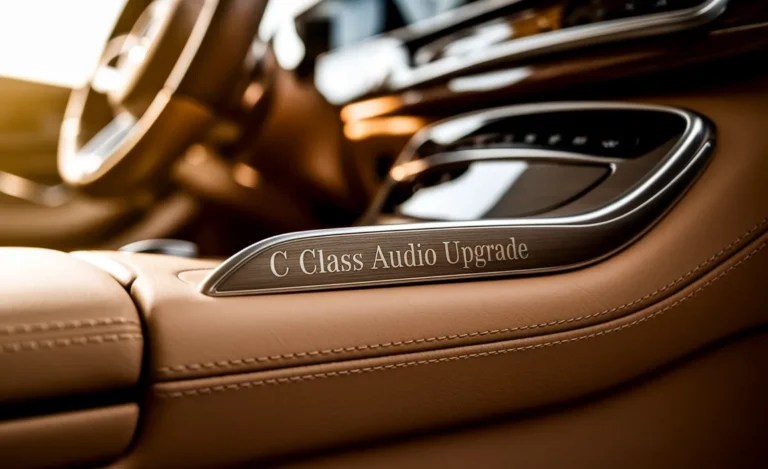C Class Aerodynamics: Ultimate Performance Perfected
Unlock the secrets of your Mercedes-Benz C-Class’s aerodynamic design. This guide explains how its sleek shape reduces drag and improves efficiency, enhancing your driving experience. Discover the engineering marvels that keep your C-Class performing at its best on every journey.

Welcome, fellow Mercedes-Benz enthusiasts! Today, we’re diving deep into the often-overlooked science that makes our C-Class vehicles so exceptional: aerodynamics. You might think of a car’s looks and luxury first, but beneath that beautiful skin lies a carefully sculpted form designed to slice through the air. This isn’t just about making the car look fast; it’s about making it be fast, efficient, and stable.
Understanding C-Class aerodynamics can truly elevate your appreciation for the engineering packed into every C-Class. From how it handles at highway speeds to its fuel economy, the air moving around your car plays a massive role. Don’t worry if you’re not an engineer; I’m here to break down this fascinating topic into easy-to-grasp concepts. We’ll explore the key components, why they matter, and how Mercedes-Benz’s dedication to aerodynamic perfection benefits you directly.
Get ready to see your C-Class in a whole new light as we uncover the wind-whispering technology that defines its ultimate performance. Stay with me, and by the end, you’ll be able to spot and appreciate the aerodynamic mastery in action!
What is Aerodynamics in C-Class Cars?
Aerodynamics, at its core, is the study of how air moves around moving objects. For a Mercedes-Benz C-Class, this translates into designing the car’s exterior shape to manage airflow as effectively as possible. The primary goals are to reduce drag (resistance from the air) and increase downforce (pressure pushing the car onto the road).
Think of pushing your hand out of a car window at speed. You feel that resistance? That’s air drag. A well-designed car minimizes this feeling by allowing air to flow smoothly over and around it. Reduced drag means better fuel efficiency and a quieter ride. Increased downforce, on the other hand, is crucial for stability and grip, especially when cornering at higher speeds, giving you that confident Mercedes-Benz feel.
Mercedes-Benz invests heavily in aerodynamic research and development, using advanced computational fluid dynamics (CFD) simulations and wind tunnel testing. This meticulous process ensures that every curve, vent, and spoiler on the C-Class is purposefully shaped to interact with the air in the most beneficial way.
Why is Aerodynamics Important for Your C-Class?
The impact of good aerodynamics on your C-Class is significant and spans several key aspects of your driving experience and the car’s technical performance. It’s not just a cosmetic detail; it’s a fundamental engineering principle.

- Fuel Efficiency: Reducing air resistance means the engine doesn’t have to work as hard to push the car through the air. This directly translates to lower fuel consumption, saving you money at the pump and reducing your environmental footprint.
- Performance and Handling: Optimized airflow can generate downforce, which presses the tires onto the road surface. This improved grip is vital for maintaining stability during high-speed driving and cornering, allowing you to drive with greater confidence and control.
- Driving Stability: Aerodynamic forces help keep the car planted on the road, especially at higher speeds. This stability is a hallmark of Mercedes-Benz vehicles, contributing to a smooth and secure ride, even in challenging conditions.
- Reduced Wind Noise: A car that manages airflow effectively will experience less turbulence around its body. Less turbulence means less noise, leading to a more comfortable and serene cabin environment for you and your passengers.
- Cooling: Specific aerodynamic features, like carefully designed air intakes, are engineered to guide airflow to critical components such as the engine radiators and brakes. This ensures these systems operate at optimal temperatures, preventing overheating and maintaining performance.
Key Aerodynamic Components of the Mercedes-Benz C-Class
Your C-Class is a symphony of design elements, many of which are directly contributing to its aerodynamic prowess. Let’s break down some of the most important parts:

1. Bodyshell Shape
The overall form of the C-Class is its most significant aerodynamic tool. Mercedes-Benz designers meticulously shape the body, focusing on:
- Smooth Transitions: The lines from the front bumper, along the hood and roof, and down to the rear bumper are designed to be as uninterrupted as possible. This allows air to flow smoothly over the vehicle without creating excessive turbulence.
- Tapered Rear End: A slightly tapered rear helps to minimize the low-pressure wake behind the car. This reduces “drag” caused by the air trying to fill in that space.
- Flush Surfaces: Features like door handles, mirrors, and even windshield wipers are designed to sit as flush as possible to the bodywork, reducing sources of air disturbance.
2. Front End Design
The front of the C-Class is engineered to manage incoming air efficiently.
- Grille: While designed for aesthetics, the grille also plays a role in directing air. Some models feature “active grille shutters” that can close to improve aerodynamics when less cooling is needed, and open when the engine requires more airflow.
- Front Splitter/Airdam: A subtle lip or extension at the bottom of the front bumper helps to manage the airflow going underneath the car and can contribute to directing air towards the cooling systems or managing lift.
- Air Intakes: Strategically placed intakes channel air to the engine’s cooling system and other components. Their shape and position are carefully calculated to maximize airflow while minimizing disruption to the overall aerodynamic profile.
3. Underbody Paneling
What you can’t see is often as important as what you can. The underside of the C-Class is far from flat.
- Smooth Paneling: A flat, smooth underbody reduces turbulence generated by the rotating wheels and chassis components. This significantly cuts down on drag.
- Diffusers: Particularly at the rear of the underbody, a diffuser is shaped to accelerate the airflow. As the air speeds up exiting the diffuser, it creates a low-pressure area, which helps to pull the car down onto the road (increasing downforce) and reduce drag.
4. Rear End Design & Spoiler
The rear of the car is crucial for managing how air separates from the vehicle.
- Tail Lights: Even the shape of the tail lights is considered to guide airflow cleanly away from the car.
- Integrated Spoiler/Lip Spoiler: Many C-Class models feature a small, subtle spoiler or lip integrated into the trunk lid. This can help to manage the airflow at the rear, reducing drag and providing a small amount of downforce for improved stability. For sportier AMG variants, more pronounced wings might be present for increased downforce.
5. Wheels and Tires
While primarily functional, the design of wheels and tires also impacts aerodynamics.
- Wheel Design: Aerodynamically optimized wheels are designed with fewer intricate spokes or features that can disrupt airflow. Some have specific patterns to channel air away from the brakes or bodywork.
- Tire Clearance: The gap between the tire and the fender well is minimized where possible to reduce the amount of air that can get trapped and create turbulence.
How Mercedes-Benz Tests C-Class Aerodynamics
Mercedes-Benz employs rigorous testing methods to perfect the aerodynamics of every C-Class model. This process ensures that the theoretical designs translate into real-world performance benefits.

1. Computational Fluid Dynamics (CFD)
Before any physical prototype is built, engineers use sophisticated computer software to simulate airflow. CFD allows them to visualize how air interacts with the car’s design virtually.
- Virtual Prototyping: Engineers can test thousands of design variations digitally, identifying potential issues and optimizing shapes without the cost and time of building physical models.
- Detailed Analysis: CFD provides in-depth data on pressure distribution, airflow velocity, and turbulence across the entire vehicle surface.
- Predicting Performance: This technology helps predict drag coefficients, lift, and downforce characteristics, guiding the physical design process.
You can learn more about the principles of fluid dynamics from the NASA Glenn Research Center, which offers excellent foundational knowledge.
2. Wind Tunnel Testing
Once a physical design is solidified, it undergoes testing in a wind tunnel.
- Scale Models and Full-Size Vehicles: Both scaled-down models and full-size C-Class prototypes are placed in the wind tunnel.
- Simulating Road Conditions: Powerful fans generate precisely controlled airflow to mimic driving speeds. A moving belt system under the car simulates the relative motion of the road.
- Measuring Forces: Sensitive instruments measure the forces acting on the car, such as drag and lift, and detailed visual studies (like smoke trails) reveal exactly how air flows over its surfaces.
- Refinement: The data gathered in the wind tunnel allows engineers to make minor adjustments to body panels, spoilers, and other components to further refine aerodynamic performance.
The results from CFD and wind tunnel testing are often cross-referenced and validated to ensure the highest level of accuracy and performance.
Aerodynamic Differences: C-Class vs. AMG C-Class
While all C-Class models benefit from Mercedes-Benz’s commitment to aerodynamics, there are distinct differences, especially when comparing a standard C-Class to its high-performance AMG counterparts.
Standard C-Class models prioritize a balance between efficiency, comfort, and understated elegance. Their aerodynamic features are designed to minimize drag for better fuel economy and reduce wind noise, creating a quiet cabin experience. The exterior styling is sleek and sophisticated, with subtle aerodynamic aids.
AMG C-Class models, on the other hand, are engineered for maximum performance. Their aerodynamic packages are significantly more aggressive and functional, focused on generating substantial downforce for superior grip and high-speed stability. This often includes:
| Feature | Standard C-Class | AMG C-Class |
|---|---|---|
| Front Bumper | Integrated, smooth design; focus on cooling airflow. | More aggressive AMG-specific design with larger air intakes for enhanced cooling and aerodynamic profiling. Often includes a front splitter. |
| Side Skirts | Subtle, flowing design. | Often more pronounced, designed to manage airflow along the car’s flanks and reduce turbulence. |
| Rear Spoiler | Optional or integrated lip spoiler for subtle downforce and drag reduction. | More prominent AMG spoiler (e.g., larger lip spoiler or a more aggressive wing on performance variants) for significant downforce increase. |
| Underbody | Smooth panels for drag reduction. | Engineered with larger diffusers and optimized airflow channels for maximum downforce. |
| Wheels | Variety of designs, some optimized for aero. | Aerodynamically optimized wheel designs are common, often with specific patterns to aid airflow. |
| Primary Goal | Efficiency, quietness, pleasing aesthetics. | Maximum downforce, high-speed stability, aggressive styling. |
The AMG variants often feature specific aerodynamic elements that are not just for show but are critical for handling at their much higher performance limits. For example, the AMG C 63 S might have a specifically tuned rear diffuser that is significantly larger and more aggressive than the standard C-Class, creating a substantial tractive force.
Maintaining Your C-Class’s Aerodynamics
While your C-Class’s aerodynamic design is built to last, certain aspects can be maintained or, unfortunately, compromised. Regular care ensures you continue to benefit from Mercedes-Benz’s engineering.
- Keep it Clean: Regularly wash your car to remove dirt, debris, and road salt. Accumulated grime can disrupt smooth airflow. Pay attention to the undercarriage and wheel wells.
- Inspect Body Panels: After any minor collisions or even just from daily driving, check for dents, misaligned panels, or missing trim pieces. Even small imperfections can affect airflow.
- Check Mirrors and Seals: Ensure side mirrors are securely attached and not damaged. Also, inspect rubber seals around doors and windows, as worn seals can contribute to wind noise and allow unwanted air intrusion.
- Tire Pressure: Properly inflated tires not only improve handling and fuel economy but also contribute to predictable aerodynamics around the wheels and wheel wells. Check your owner’s manual for the recommended tire pressures.
- Avoid Unnecessary Modifications: While aftermarket parts can be appealing, poorly designed or installed aerodynamic aids (like excessively large spoilers or body kits) can actually harm your C-Class’s intended aerodynamic balance, leading to increased drag, instability, or performance issues. Always opt for reputable brands and professional installation if you choose to modify.
- Inspect for Underbody Damage: Especially if you’ve encountered rough roads or speed bumps, check the undertray and aerodynamic panels. Scrapes or missing pieces can reduce the effectiveness of the underbody design. You can use a flashlight to inspect from the side or, if you have the means and confidence, jack up your vehicle safely (using appropriate jack stands on a level surface, following Mercedes-Benz’s recommended jacking points) to get a better look.
For a comprehensive guide on general vehicle maintenance, Edmunds provides excellent, practical advice for car owners.
Conclusion
The aerodynamics of your Mercedes-Benz C-Class are a testament to the brand’s commitment to engineering excellence, blending form and function in a way that enhances every drive. From the subtle curves of the bodyshell to the intricate designs beneath the car, every element is meticulously crafted to manage airflow, reducing drag and increasing stability.
Understanding these principles not only deepens your appreciation for your vehicle but also helps you understand why it performs the way it does – whether it’s the whisper-quiet ride on the highway, the impressive fuel efficiency, or the confident handling through corners. By maintaining your C-Class and respecting its design, you ensure that these aerodynamic advantages continue to contribute to your driving pleasure and the vehicle’s longevity.
So, the next time you’re behind the wheel of your C-Class, take a moment to appreciate the invisible forces at play, the result of countless hours of research, simulation, and testing. It’s this dedication to perfection, down to the very air that flows around the car, that makes
C-Class Aerodynamics FAQs
What is the drag coefficient (Cd) for a C-Class?
The specific drag coefficient (Cd) varies slightly depending on the exact model year, body style (sedan, coupe, wagon), and optional aerodynamic packages fitted. However, modern Mercedes-Benz C-Class sedans are known for achieving very low Cd values, often in the range of 0.24 to 0.27. This puts them among the most aerodynamically efficient vehicles in their class.
Do spoilers on a C-Class actually improve performance?
Yes, for performance-oriented models like the AMG C-Class, spoilers are intentionally designed to increase downforce, which improves tire grip and stability at high speeds. While a subtle lip spoiler on a standard C-Class might offer minor benefits for drag reduction and stability, its impact is less dramatic than the functional wings and diffusers found on AMG variants.
How does the C-Class’s aerodynamics affect fuel economy?
Excellent aerodynamics significantly improve fuel economy. By reducing the resistance the car encounters as it moves through the air, the engine requires less energy to maintain speed. This means you’ll generally achieve better miles per gallon (MPG) on the highway with a more aerodynamically efficient car like the C-Class.
Can I improve my C-Class’s aerodynamics?
While major aerodynamic changes are best left to factory engineers or highly specialized tuners, keeping your car clean, ensuring all body panels are aligned, and maintaining proper tire inflation are simple ways to ensure you’re getting the most out of your car’s designed aerodynamics. Avoid adding aftermarket parts that haven’t been rigorously tested, as they can often worsen performance.
What is the “active aero” often mentioned for Mercedes-Benz cars?
“Active aero” refers to aerodynamic components that can change their position or shape dynamically to optimize performance for different driving conditions. A common example on some Mercedes-Benz models is active grille shutters, which close to reduce drag when less engine cooling is needed and open to allow maximum airflow when the engine is working hard.
Does the C-Class coupe have different aerodynamics than the sedan?
Generally, yes. Coupe versions often have a more steeply raked roofline and a sleeker profile, which typically results in a lower drag coefficient compared to the sedan. The design is optimized for a sportier visual appeal and can lead to slightly improved aerodynamic efficiency, though both are highly optimized.






